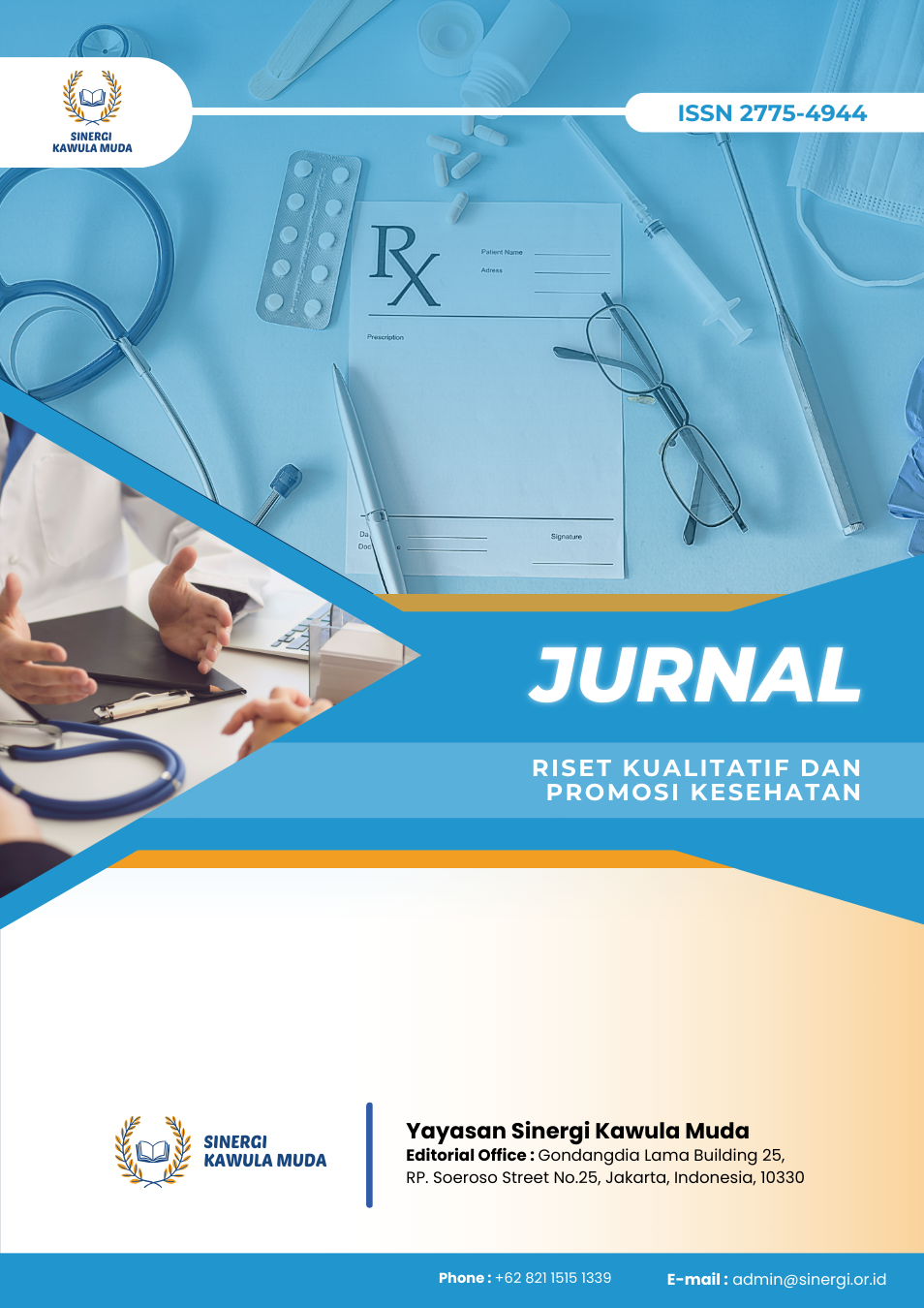Analysis of Risk Factors for Heart Failure in Outpatients at The Undata Regional General Hospital, Central Sulawesi Province
DOI:
https://doi.org/10.61194/jrkpk.v4i1.773Keywords:
Heart Failure, Obesity, Physical Activity, Smoking, Case-Control, Smoking CessationAbstract
Heart failure is one of the highest causes of death from cardiovascular disease, especially in middle and low income countries. This study aims to analyze the risk factors for heart failure in outpatients at Undata Hospital, Central Sulawesi Province. This study uses an approach case-control with a total sample of 134 respondents, consisting of 67 cases and 67 controls determined through techniques purposive sampling. Primary data was collected through structured questionnaires, while secondary data was obtained from hospital medical records. Data analysis was carried out using univariate and bivariate approaches using tests Odds Ratio (OR) to determine the relationship between independent variables (obesity, physical activity, smoking history) and the incidence of heart failure. The results showed that obesity had an OR of 1.149 (95% CI: 0.553–2.385), physical activity had an OR of 3.436 (95% CI: 1.048–11.273), and smoking history had an OR of 1.446 (95% CI: 0.655–3.194). These findings indicate that physical inactivity is a significant risk factor for heart failure, while obesity and smoking also contribute although not statistically significant. This research emphasizes the importance of preventive intervention on lifestyle factors to reduce the incidence of heart failure in society.
References
American Heart Association. (n.d.). What is heart failure? Retrieved from https://www.heart.org/en/health-topics/heart-failure/what-is-heart-failure
Febby, F., Arjuna, A., & Maryana, M. (2023). Dukungan keluarga berhubungan dengan kualitas hidup pasien gagal jantung. Jurnal Penelitian Perawat Profesional, 5(2), 691–702. https://jurnal.globalhealthsciencegroup.com/index.php/JPPP/article/view/1537
Gao, H., Wang, X., Chen, Z., et al. (2023). Global, regional, and national burden of heart failure and its underlying causes, 1990–2021: Results from the Global Burden of Disease Study 2021. Biomarker Research, 11(1), 1–15. https://doi.org/10.1186/s40364-025-00728-8
Health.com. (2024, November 9). What causes congestive heart failure? Retrieved from https://www.health.com/congestive-heart-failure-causes-8726776
Iqbal, M. F., & Handayani, S. (2022). Terapi non farmakologi pada hipertensi. Jurnal Untuk Masyarakat Sehat (JUKMAS), 6(1), 41–51. https://doi.org/10.52643/jukmas.v6i1.2113
Iswahyudi, A. A. A. Z., & Darma, S. (2024). Pengaruh aktivitas fisik terhadap kejadian gagal jantung kongestif di RS Ibnu Sina Makassar tahun 2022. Innovative: Journal of Social Science Research, 4(1), 11010–11021. https://j-innovative.org/index.php/Innovative/article/view/8909
Kementerian Kesehatan Republik Indonesia. (2023). PNPK 2023 - Tata Laksana Gagal Jantung Pada Anak. Retrieved from https://kemkes.go.id/id/pnpk-2023---tata-laksana-gagal-jantung-pada-anak
Kementerian Kesehatan Republik Indonesia. (2024). Gagal jantung. https://ayosehat.kemkes.go.id/gagal-jantung
Khan, M. S., Shahid, I., Bennis, A., Rakisheva, A., Metra, M., & Butler, J. (2024). Global epidemiology of heart failure. Nature Reviews Cardiology, 21(10), 717–734. https://doi.org/10.1038/s41569-024-01046-6
Latifardani, R., & Hudiyawati, D. (2023). Fatigue berhubungan dengan kualitas hidup pada pasien gagal jantung. Jurnal Keperawatan Silampari, 6(2), 1756–1766. https://doi.org/10.31539/jks.v6i2.5697
Lippi, G., & Sanchis-Gomar, F. (2020). Global epidemiology and future trends of heart failure. AME Medical Journal, 5, 15. https://doi.org/10.21037/amj.2020.03.03
Lumi, A. P., Joseph, V. F. F., & Polii, N. C. I. (2021). Rehabilitasi jantung pada pasien gagal jantung kronik. Jurnal Biomedik (JBM), 13(3), 309–316. https://doi.org/10.35790/jbm.v13i3.33448
Manurung, R. J., Tarigan, M., & Sitohang, N. A. (2024). Gambaran efikasi diri dan perawatan diri pada pasien gagal jantung. Holistik Jurnal Kesehatan, 18(7), 909–916. https://doi.org/10.33024/hjk.v18i7.414
Marbun, A. P. S., Tarigan, M., & Sitohang, N. A. (2024). Gambaran pengetahuan tentang perilaku perawatan diri pada pasien gagal jantung. Journal of Telenursing (JOTING), 6(2). https://doi.org/10.31539/joting.v6i2.11158
Metra, M., & Teerlink, J. R. (2017). Heart failure. The Lancet, 390(10106), 1981–1995. https://doi.org/10.1016/S0140-6736(17)31071-1
Nabila, A. Q., & Nurkhalis. (2024). Korelasi antara indeks massa tubuh dan visceral fat dengan variabilitas denyut jantung pada pasien gagal jantung sistolik dengan penurunan fraksi ejeksi. Jurnal Kedokteran Nanggroe Medika, 7(2), 34–43. https://www.jknamed.com/jknamed/article/view/291
Perhimpunan Dokter Spesialis Kardiovaskular Indonesia (PERKI). (2023). Pedoman tatalaksana gagal jantung. https://www.inaheart.org/guidelines/pedoman-tatalaksana-gagal-jantung-2023
Rahayu, M. S., Susanto, N. T., & Azalia, R. K. (2024). Kajian potensi interaksi obat pada pasien geriatri dengan gagal jantung di RSUD Dr. Moewardi Surakarta tahun 2023. Jurnal Buana Farma, 4(3), 260–274.
Shahim, B., Kapelios, C. J., Savarese, G., & Lund, L. H. (2023). Global public health burden of heart failure: An updated review. Cardiac Failure Review, 9, e11. https://doi.org/10.15420/cfr.2023.05
World Health Organization. (2024). Cardiovascular diseases (CVDs). Retrieved from https://www.who.int/news-room/fact-sheets/detail/cardiovascular-diseases-(cvds)
World Health Organization. (2024). Heart failure (congestive heart failure). Retrieved from https://www.ncbi.nlm.nih.gov/books/NBK430873/
Downloads
Published
Issue
Section
License
Copyright (c) 2025 Jurnal Riset Kualitatif dan Promosi Kesehatan

This work is licensed under a Creative Commons Attribution 4.0 International License.





